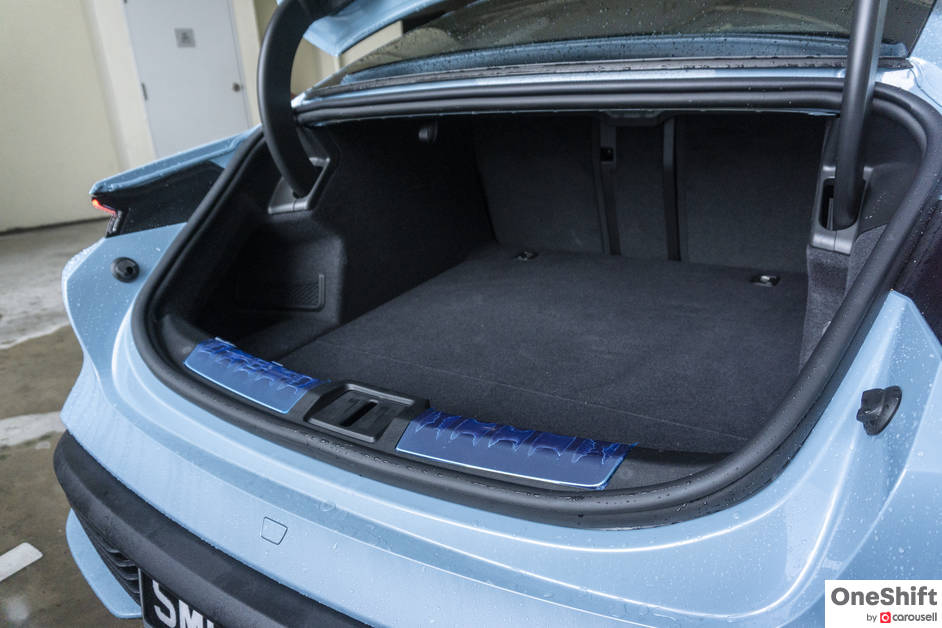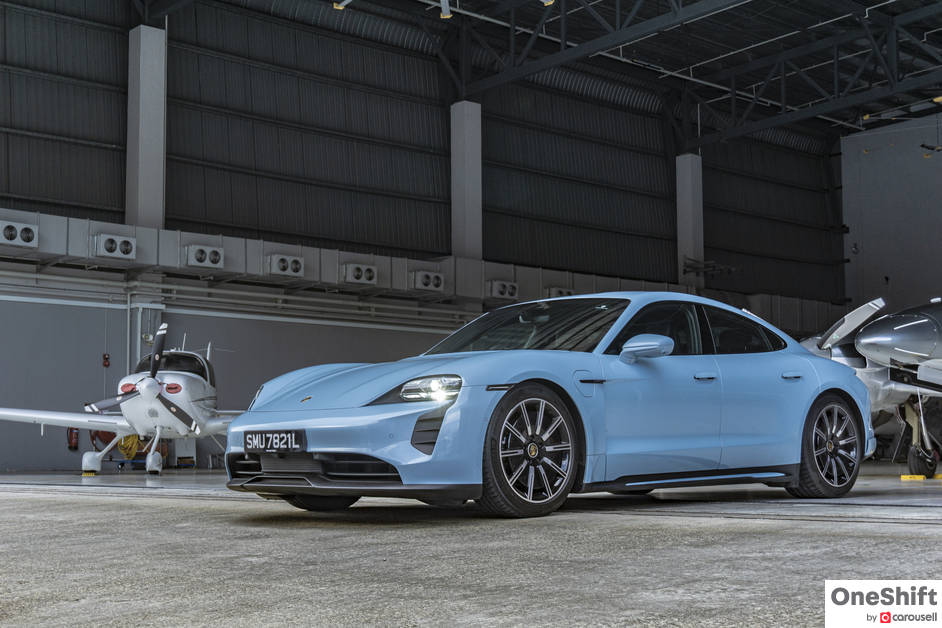
When Porsche develops something, it is extremely detailed during the gestation period. So when it came to building the first all-electric Porsche, everything had to be designed from ground up. There simply wasn’t a solution out there that worked for the brand, so it created its own. The result is a vast number of innovations in the new Porsche Taycan that altogether truly makes it a game changer for the EV segment.

Porsche had to do a careful balancing act between tradition and modernity with the Taycan’s looks. It could not abandon its distinctive design language, yet the car had to be unique enough to appeal to a new set of customers more interested in kWh than bhp. I think Porsche achieved its objective really well. The Taycan may remind some of the Panamera, but in person, it is more curvaceous, lithe and compact. The finer details like the rear Porsche lettering in glass-effect, the compact four-point headlights and flushed door handles are tastefully applied. Even the Frozen Blue Metallic paint suits the car so well.

The main bugbear I have with the car’s exterior as tested is its 20-inch Sport Aero wheels, which are not only a S$10k option but also look quite dull. Thankfully, there are other far prettier options from the factory you can select from. Also the SportDesign Package, like in other Porsche models, feels a tad over-the-top and is not quite necessary.

Very much like the Taycan’s exterior, its interior is uncannily familiar but also refreshingly new. The first thing you would notice is the car switching on by itself once you get in; there is no need to press the start button.

What appears in front of you is the party piece of the interior: a 16.8-inch curved instrument cluster that draws smartphones out for a photo all the time. One wonders why other car manufacturers haven’t caught on to this earlier, given we already have curved TVs at home for a while now. It looks terrifically futuristic yet also highly functional, easily controlled with toggles from the steering wheel.

You’d notice the gear lever is now mounted onto the dash, looking far more appropriate here than it does in the 992. That frees up space on the centre console for two screens, which reminds me of the MMI in the Audi A6 Avant I recently test drove. The main 10.9-inch display houses all main controls while the smaller 8.4-inch panel below it is mainly for climate control settings and handwriting. They are OK to use, but I’d much rather buttons myself. If you wanted yet another screen, you could also option one for the front passenger and they would be very occupied indeed.

With all those electronics keeping one busy, one may not realise that leather is completely missing from the interior, a near S$17k option. Race-Tex microfibre made from recycled polyester fibres replaces cow hide which apparently produces 80% less CO2 than traditional materials during manufacturing. The floors also use recycled fibre Econyl which are made from, among other things, recycled fishing nets. While these materials are indeed virtually unheard of in the industry, they do feel less luxurious than they ought to be in a car as expensive as the Taycan. Some passengers also commented on the roughness of the seat’s Race-Tex on the skin.

Practicality wise, the Taycan has space in its front boot and back. There’s ample storage but I wished the Taycan had a hatchback like the Panamera, for the sedan-like opening for the boot does reduce the practicality of the car a fair bit in terms of loading options and aperture.

The Taycan 4S comes as standard with 530PS but the test car was equipped with Performance Battery Plus which ups the output to 571PS and also increases the range from 365km to 414km. There’s no questioning how fast the car is - most performance EVs are quick by default - but what’s notable is how natural the power delivery feels. Unlike the “instantaneous torque” that I expected, in the Taycan it felt metered out progressively just like the power curve of an internal combustion engine (ICE). It could also be the two-speed gearbox which gives the familiar sensation of a gear change. This is unlike any EV I have tried before and allows people used to ICE to feel comfortable with the transition.

In fact, it’s not only the power that felt natural. The Taycan braked just like any conventional car, with no sudden jerks due to recuperation. This is because the Taycan doesn’t recuperate once you release the throttle pedal; it only does so when you brake. And when it does, up to 90% of the braking is done by regeneration, not that you would ever feel it. If you don’t depress the brake, the car would coast. This makes one wonder if the Taycan would be even more efficient had it started to recuperate the moment throttle is released.

But I suppose efficiency is not really a huge reason why you’d choose the Taycan. The test car was optioned with the full handling works - Porsche Torque Vectoring (PTV) Plus, Dynamic Chassis Control (DCC) Sport, Sport Chrono and Rear-Axle Steering - so the intent was clear that this is meant to be a Porsche, not just an EV. And what a Porsche it is! Get the car to some corners and you would marvel at its grip levels. There is an electric motor at each axle, effectively making the car all wheel drive, but torque can be shifted 100% to either axle so it does feel rear driven especially in the sportier modes.

Because its centre of gravity is lower than that of the Panamera, it is a far better handler than its conventional saloon sibling. It is more agile, balanced and eager. If not for the car’s weight, which you would feel when pushing the car to its limits and braking hard, it truly feels more like the 718 or 911 than any of Porsche’s other 4-door models.

You would think with all that performance, the car may ride harshly. Quite the opposite - it is the most comfortable Porsche I have driven. The three-chamber air suspension is similar technology to what you get in the Panamera, but it feels even more sorted here. Perhaps due to the more ideal weight distribution of the Taycan, the suspension has less to deal with. It was absolutely serene riding in the Taycan, no doubt also helped by the fabulously low noise levels that come with a low Cd value of 0.22.

I did not get to charge the Taycan during the test drive, but it must be said that Porsche thought of this too. It’s not enough to build a great driving EV, one must be able to charge it quickly too. With a system voltage of 800V (versus 400V in conventional EVs), the Taycan can charge from 5% to 80% SoC (state of charge) in as fast as 22.5 minutes. That in itself is something to behold. The 800V technology also means less high-voltage cabling is needed, reducing weight.

Another point worth mentioning is the Taycan’s permanently excited synchronous motors (cool name). These contain permanent magnets that give high power constancy. The motors also utilise hairpin winding which allows more copper to be packed into it than usual as well as more efficient cooling. What this means is the car can ensure repeatability of its performance far more reliably than conventional EVs. This is important in a race setting where lap times are a concern.

There is so much more to say about the Taycan simply because a Porsche-level of engineering has been lavished on the car. I could easily be writing a thesis about the car if I had laid out every feature. But what is more important is, at the very basic level to use the car every day like any other, I reckon the Taycan is the most sorted EV in the market. If you were in the market for a Panamera, I cannot think of a good reason why you would pick one over the Taycan save for the fact that you may not have access to a charging point at a non-landed property.

The Taycan is superior in almost every measure, and I reckon it is a more complete sports car than any comparable EV out there too. I am even more excited for the base Taycan, for I think it will have more than enough pace but with rear wheel drive, less tax and a more affordable price tag. That would suit the Singapore market extremely well.

*Special thanks to WingsOverAsia for allowing us to shoot at their aircraft hangar.
Credits: Text by James Wong; Photos by James Wong and Clifford Chow








Get the Best Price for your used car
from 500+ dealers in 24 hours

- Convenient and Hassle-Free
- Consumer Protection
Transparent Process
With No Obligation









